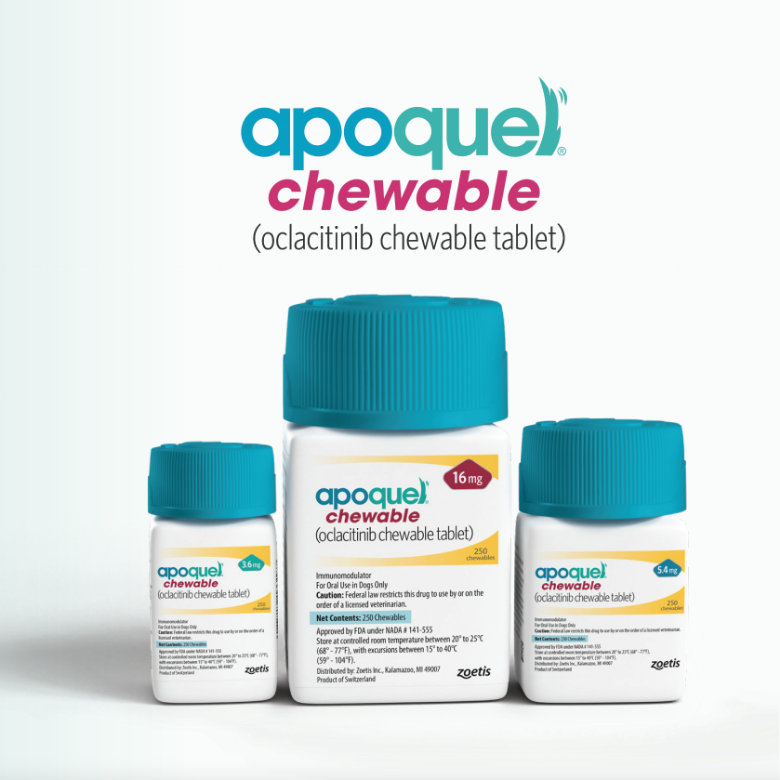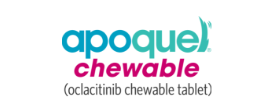The safety profile of Apoquel is supported by pharmacovigilance data over 5 years that showed adverse reactions were rare* and consistent with pivotal safety and efficacy studies1
The safety profile of Apoquel is supported by pharmacovigilance data over 5 years that showed adverse reactions were rare* and consistent with pivotal safety and efficacy studies1



The most commonly reported adverse events were very rare* and in decreasing order were: vomiting, diarrhea, lethargy, anorexia, and blood-work changes. Less than 1 dog out of 10,000 treated experienced the most common individual adverse reactions.
The most commonly reported adverse events were very rare* and in decreasing order were: vomiting, diarrhea, lethargy, anorexia, and blood-work changes. Less than 1 dog out of 10,000 treated experienced the most common individual adverse reactions.
*Rare is defined as more than 1 but less than 10 dogs reacting per 10,000 dogs treated; very rare is defined as less than 1 dog reacting per 10,000 dogs treated.2 Reported incidence rate (calculated) is an estimated rate. Includes all adverse reactions regardless of whether the product was administered per label directions, concomitantly or if a potential causal relationship existed.1
Safe to use in dogs 12 months of age and older
Short-term side effects in a clinical trial
Most common side effects in a short-term clinical trial included vomiting and diarrhea3
Can be used long term for maintenance therapy
Not for use in dogs with serious infections or for use in breeding, pregnant or lactating dogs
Can be used concomitantly with many medications, including nonsteroidal anti-inflammatory drugs (NSAIDs), anti-infectives, parasiticides, antifungals and allergen-specific immunotherapy4
The use of Apoquel has not been evaluated in combination with other systemic immunosuppressants, such as corticosteroids and cyclosporines
Study Results
Adverse events from 2 studies: vs placebo and prednisolone in dogs with allergic dermatitis
Apoquel Tablet vs placebo3
Apoquel Tablet vs prednisolone5
Adverse events from 2 studies: vs placebo and Atopica® in dogs with atopic dermatitis
Apoquel Tablet vs placebo6
Apoquel Tablet vs Atopica® (cyclosporine capsules, USP)7
You may also be interested in
References: 1. Data on file, A Five-Year Post-Approval Safety Review for Apoquel® in the US (May 2013 to August 2018), Zoetis Inc. 2. Volume 6C Summary of the Product Characteristics: SPC European Commission, Brussels. 1 Vol. 6C. July 10, 2006, 1-11. 3. Cosgrove SB, Wren JA, Cleaver DM, et al. Efficacy and safety of oclacitinib for the control of pruritus and associated skin lesions in dogs with canine allergic dermatitis. Vet Dermatol. 2013;24(5):479-e114. doi:10.1111/vde.12047 4. Cosgrove SB, Cleaver DM, King VL, et al. Long-term compassionate use of oclacitinib in dogs with atopic and allergic skin disease: safety, efficacy and quality of life. Vet Dermatol. 2015;26(3):171-e35. doi:10.1111/vde.12194 5. Gadeyne C, Little P, King VL, et al. Efficacy of oclacitinib (Apoquel®) compared with prednisolone for the control of pruritus and clinical signs associated with allergic dermatitis in client-owned dogs in Australia. Vet Dermatol. 2014;25(6):512-e86. doi:10.1111/vde.12166 6. Cosgrove SB, Wren JA, Cleaver DM, et al. A blinded, randomized, placebo-controlled trial of the efficacy and safety of the Janus kinase inhibitor oclacitinib (Apoquel®) in client-owned dogs with atopic dermatitis. Vet Dermatol. 2013;24(6):587-e142. doi:10.1111/vde.12088 7. Little PR, King VL, Davis KR, et al. A blinded, randomized clinical trial comparing the efficacy and safety of oclacitinib and ciclosporin for the control of atopic dermatitis in client-owned dogs. Vet Dermatol. 2015;26(1):23-e8. doi:10.1111/vde.12186
Cytopoint Indications
Cytopoint has been shown to be effective for the treatment of dogs against allergic dermatitis and atopic dermatitis.
Apoquel and Apoquel Chewable Indications
Control of pruritus associated with allergic dermatitis and control of atopic dermatitis in dogs at least 12 months of age.
Apoquel and Apoquel Chewable Important Safety Information
Do not use Apoquel or Apoquel Chewable in dogs less than 12 months of age or those with serious infections. Apoquel and Apoquel Chewable may increase the chances of developing serious infections, and may cause existing parasitic skin infestations or pre-existing cancers to get worse. Consider the risks and benefits of treatment in dogs with a history of recurrence of these conditions. New neoplastic conditions (benign and malignant) were observed in clinical studies and post-approval. Apoquel and Apoquel Chewable have not been tested in dogs receiving some medications including some commonly used to treat skin conditions such as corticosteroids and cyclosporines. Do not use in breeding, pregnant, or lactating dogs. Most common side effects are vomiting and diarrhea. Apoquel and Apoquel Chewable have been used safely with many common medications including parasiticides, antibiotics and vaccines.
See full Prescribing Information for Apoquel and full Prescribing Information for Apoquel Chewable.







